October, 1966
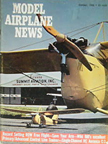
Model Airplane News Cover for October, 1966
Aeronca C-3 "Collegiate"
Click to Enlarge
Here is what the blurb about the cover has to say:
"... Father and son team of Aeronca C-3 "Collegiate" version in full scale and the Aeronca C-3 model featured on pages 26-28 of this issue. Full size plane "Collegiate" belongs to Kip Dupont of the famous Dupont family and is flown about twice a year. Our model is a different story - it is flown at every possible opportunity. Cover photo by Bill Northrop ..."
About the Model
The original Aeronca C-3 was a very simple, easy-to fly design that adapts itself wvery well to radio control, especially single channel sets that have limited control. All the weight is over the landing gear and the wing area is generous. The model was designed by Ralph Fidance
You may read about this model by clicking to enlarge the photos below.
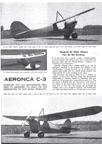
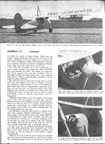
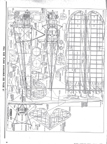
Aeronca C-3 "Collegiate"
Designed by Ralph Fidance
Click to Enlarge
The Dupont Family and Aviation
"Kip" Dupont (mentioned in the blurb) is the son of Richard Dupont, who has a distinguished place in aviation history.
Richard Chichester du Pont (January 2, 1911 - September 11, 1943) was an American businessman and an aviation and glider pioneer who was a member of the prominent Du Pont family. As a young boy he developed an enthusiasm for aviation and took flying lessons. At the University of Virginia, he founded a campus soaring club. In 1932, he went to study aviation at the Curtiss-Wright Technical Institute. That year, he flew an open-cockpit airplane up the Amazon River.
In 1933, Richard du Pont partnered with Hawley Bowlus to set up the Bowlus-du Pont Sailplane Company, a glider manufactory in San Fernando, California. Du Pont made a record flight in one of their sailplanes on September 21, 1933, taking off from Afton Mountain into the Rockfish Gap and gliding 121.6 miles to Frederick, Maryland. The firm remained in business for only a few years, ceasing operations in September 1936.
Richard du Pont and his older brother Felix established the forerunner to US Airways. Their All American Aviation Company was at first an airmail service that eventually serviced parts of Pennsylvania, West Virginia, Kentucky, and Ohio. In 1949, the company began passenger service and changed its name to All American Airways then to Allegheny Airlines.
During World War II, the United States War Department created the American Glider Program. Richard du Pont was made a Special Assistant to General "Hap" Arnold and placed in charge of the glider program at Army Air Force Headquarters. On September 11, 1943, at March Air Field in California, he was killed when the experimental XCG-16 glider in which he was a passenger crashed during a demonstration flight. (We have profiled Hawley Bowlus and the XFG-16 in our treatment of the April, 1946 issue of MAN) His brother, Major Felix du Pont, was appointed to succeed him as head of the glider program
.A three-time U.S. National Soaring Champion, since 1947 the Richard C. du Pont Memorial Trophy has been awarded annually to the U.S. National Open Class Soaring Champion. An American Legion post in Claymont, Delaware is named in his honor. Upon the creation of the Soaring Hall of Fame in 1954 by the Soaring Society of America, Richard du Pont was part of the first group of inductees
About the Full Size Airplane
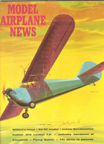
Aeronca C-3
Model Airplane News Cover Art for January, 1962
by Jo Kotula
Click to Enlarge
The Aeronca C-3 was a light plane built by the Aeronautical Corporation of America in the United States during the 1930s. Its design was derived from the Aeronca C-2. Introduced in 1931, it featured room for a passenger seated next to the pilot. Powered by a new 36-horsepower Aeronca E-113 engine, the seating configuration made flight training much easier and many Aeronca owners often took to the skies with only five hours of instruction—largely because of the C-3's predictable flying characteristics. Both the C-2 and C-3 are often described as “powered gliders” because of their gliding ability and gentle landing speeds—it was almost impossible to make a hard landing with an Aeronca because the pilot could easily see his wheels approach the runway.
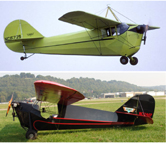
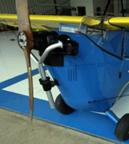
Aeronca C-3
Click to Enlarge
The C-3's distinctive razorback design was drastically altered in 1935 with the appearance of the “roundback” C-3 Master. Retaining the tubular fuselage frame construction, the C-3 Master featured a smaller vertical stabilizer and rudder with a “filled out” fuselage shape that created the new “roundback” appearance and improved the airflow over the tail. With an enclosed cabin, the 1935 C-3 Master was priced at only $1,890—just a few hundred dollars more than the primitive C-2 of 1929. The low price generated significant sales; 128 C-3 Masters were built in 1935 alone and the 500th Aeronca aircraft also rolled off the assembly line that same year.
Production of the C-3 was halted in 1937 when the aircraft no longer met new U.S. government standards for airworthiness. Many of the C-3's peculiarities—external wire braces, extensive fabric construction, single-ignition engine, and lack of an airspeed indicator—were no longer permitted. Fortunately for the legion of Aeronca owners, a “grandfather” clause in the federal regulations allowed their airplanes to continue flying, although they could no longer be manufactured.
Here is a video of the Aeronca C-3 in action:
In a small aside, you may see an Aeronca "Collegiate" in the film Flying Down To Rio. Honey Hale (Ginger Rogers) coaches the "Aerial Ballet" perched on the back of a C-3 piloted by Julio Riberio (Paul Roulien).
This unforgettable scene features scantily clad starlets cavorting while strapped to the wings of a variety of Golden Age planes.
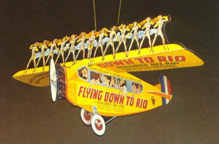
Flying Down to Rio Promotional Item
Click to Enlarge
Click Here for more information about the Aeronca C-3.

Click to go back and select another cover.
Counter for the Entire Site (not just this page..)
Home | About Lindy | Last Week's Reviews | Upcoming Events | 1940s Collecibles
The Guide - Establishments - Travel - Accessories
Music | Links | Photo Gallery | Extras | Contact